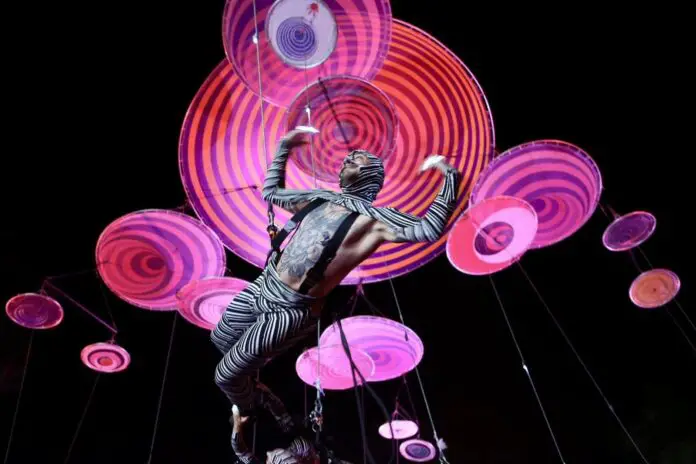This Saturday, May 25, the 17th edition of the White Night took place in the streets of downtown Mérida, where thousands of people enjoyed the participation of a thousand artists in 300 free activities held in 72 venues such as parks, museums, theaters, alternative forums, and galleries, among others.
In the vicinity of Santa Ana Park, on 60th Street, galleries in the area closed their streets and set up tables where there were activities for girls and boys, as well as subsequent events for the whole family.
The nearby museums and El Remate had activities throughout the night. The well-known celebration included all the galleries, museums, restaurants, and businesses in the area, and also called on vendors with street stalls selling clothing, jewelry, or art, as well as street food stands.
One of the most anticipated events of the night was the Muaré Experience show at El Remate de Montejo, an aerial spectacle with rock music performed by the band Duchamp Pilot, produced by Voalá Project.
The show is inspired by the rotorelief of the avant-garde plastic artist Marcel Duchamp, which seeks to generate two patterns of movement that, when combined, can generate a new random pattern, which is activated by 12 acrobats.
The spectacle begins with the ascent and descent of a white bubble in which, inside, a body gradually reveals its parts, showing the silhouette of an arm, the circumference of the legs, the shadow of the face that, on the descent, come to touch the audience. This flight system works with the help of harnesses controlled by a crane that raises or lowers the acrobats.
The rock group Duchamp Pilot enlivens the staging and, in accordance with the acrobats, intensifies the experience. The rotorelief system, or the Muaré experience, is a rotating disk that has other smaller disks attached each to the acrobats’ harnesses, which rotate the system producing a coordinated rotary movement. A synchronized flight where the ascent and descent are constant.
As the show progresses, the acrobats interact with the public, motivated by the music. At key moments of intensity, they throw confetti from the air, making the sky shine with colors as they rotate rhythmically, intertwining their bodies to create movement patterns.
El Remate de Montejo was full of families and a varied attendance. Part of the audience remained seated before the show started and, as it progressed, the organizers urged people to stand up to better enjoy the interaction with the acrobats, who would descend completely among the people, from where they would rise again into the air when a new musical piece was about to begin.
The Muaré show ended with an intense snowfall that the acrobats performed from the sky. Covering the bodies of the attendees in a thin white layer, in the midst of the warm spring. Muaré Experience had two performances, one at 21:00 and another at 23:30.
At the Anthropology Museum of the Palacio Cantón, the Ek’Balam Polyphonic exhibition was inaugurated, portraying various aspects and figures related to the Maya settlement, from the Sacred Lady, a ruler who led one of the most powerful dynasties in the region, mother of King Ukit Kan Lek Tok, to a review of the first photographic images made by Désiré Charnay, through the archaeologists who worked on the recovery of the buildings and the scientists specialized in cataloging this settlement as one of the most important cities of its time.
Another important event in the nearby museums was the inauguration of Tradition and Counterpoint. The graphic legacy of Fernando Castro Pacheco, which took place at the Cultural Center named after the Yucatecan painter.
This exhibition reviewed several facets of the Mexican muralist, such as his time at the Taller de Gráfica Popular and the production of his first works, as well as the continuity of his most important themes, such as the historical vindication of the Maya culture, at a time when revolutionary values were in effervescence.
The exhibition is a sample of engraving with a traditional theme and influenced by the avant-gardes of the early 20th century, and the tradition of nationalist muralism, booming in the graphics of the Post-Revolution in Mexico.
The theme of the peasant, and the coexistence of men and women with the land, is one of the essential topics of this period. Outside the museums, the atmosphere in restaurants, cafes, and bars on Paseo Montejo was lively.
The proposals were varied, showing a wide range of options that the center of Mérida already has. Artists and artisans had a place on the streets of Paseo Montejo, where they set up their stalls and exhibited their products to the public.
Also, the street food businesses were quite benefited, and long lines of people crowded the small shops selling hot dogs, marquesitas, or esquites.
The White Night is one of the most important massive cultural events in the state capital because it represents a great boost for local talent, but it also adds international artists of great reach. In this edition, Colombia, Cuba, Spain, and England were present.
Source: La Jornada Maya







